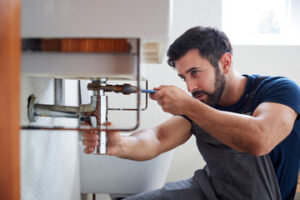A local plumber helps in the repair of toilets, drains and sinks. In addition, they help in preventing water damage from burst pipes, flooding and other plumbing disasters.

In choosing a plumber, consider the following factors to choose the best one for you. These include: the business model, equipment and insurance. Contact Ranger Plumbing Company for professional help.
Business models are a key component of any plumbing startup. They help you identify your target audience and provide a clear roadmap to achieve success. They also help you plan for growth and secure financing. In addition, they can guide you through the legal requirements for your business. You must select a business structure that fits your long-term goals and budget. Options include a sole proprietorship, partnership, limited liability company (LLC), or corporation. You should consult with an attorney or accountant to determine the best option for your needs. You must also register your business name and obtain the necessary licenses and permits to operate legally.
The most successful plumbing brands have loyal client bases. They build this by providing a unique experience and messaging that their clients can relate to. This builds an emotional connection, which translates into repeat customers and referrals. Moreover, a strong brand can differentiate itself from the competition by providing customer service that goes above and beyond.
Lastly, your marketing strategy should focus on building brand awareness and generating revenue. This can be accomplished by leveraging online and local marketing strategies. These can include search engine optimization (SEO), social media marketing, and targeted ad campaigns. You should also make sure to track your results and adjust your efforts accordingly.
Your business plan should include a competitive analysis and a detailed description of the services you’ll offer. It should also include financial projections, including startup costs, monthly expenses, and revenue forecasts. It should also contain a contingency plan to cover unforeseen expenses. Finally, it should also include a vision statement and short-term and long-term goals.
Equipment
There are a lot of tools required for plumbing work. This includes essential hand tools like pliers and wrenches, as well as power tools such as drill machines and pipe cutters. Some specialized tools include inspection cameras and leak detectors. These can help you diagnose problems and perform repair work more effectively.
A plumbing company should also have a range of specialized equipment to handle clogs and other challenging tasks. These may include drain snakes and augers, which are flexible cables with cutting blades that can remove obstructions from pipes. These tools can get into narrow spaces and are useful for removing hard-to-reach obstructions in showers and toilets. They are especially effective for clogged drains in older homes with cast-iron pipes.
Another important piece of equipment for a plumber is the drain cleaning machine. This powerful tool uses high-pressure water to clean sewer lines of grease, soap scum, and other debris. It consists of a water tank, nozzle, and an apparatus that pressurizes the water in the nozzle before it is discharged.
Other equipment includes tools for removing old valves, pipes, and fixtures. It is important to know the requirements of your area before purchasing these items. For instance, some states require special licensing and permits for plumbing companies. A license is also needed to sell parts and accessories. Before launching a new plumbing business, it is also necessary to identify your target customers. This could include homeowners or businesses. Homeowners typically need assistance with leaks and clogs, while businesses may need maintenance contracts or specialized installations. In addition, it is a good idea to research your competitors to find out what services they offer and how much they charge for them.
Insurance
Just as a plumber relies on a wide toolkit of various tools to complete its work, a plumbing business needs a comprehensive insurance portfolio that protects it from unexpected financial and legal challenges. While the right policies will not stop every mishap, they can mitigate most damages.
A typical plumber’s insurance policy consists of general liability, workers’ compensation, commercial auto, and business property insurance. The insurer will assess each of these components to determine the amount of coverage needed for your business. In addition, the insurer will consider your location and other factors that may affect the cost of your premiums.
For example, if your employees are working on a job site and an accident occurs, you may need workers’ compensation to cover their medical expenses and lost wages. Business property insurance can also help to protect your assets in the event of a theft or natural disaster. Additionally, you may want to add commercial auto insurance to cover the costs of repairs and damage caused by accidents involving your company vehicles.
Specialized insurance brokers can help you select the best insurance policy for your plumbing business. They will ask questions about your revenue, payroll, vehicles, specialized equipment, and property to provide customized service. They will then shop your coverage with multiple insurers to find the right combination of protection and affordability.
They will also review your existing policies to ensure that you have adequate coverage for all potential risks and liabilities. In addition, they will recommend coverage enhancements to align with your evolving business model. Finally, they will advocate for you during the claims process and remind you to revisit your policies on a regular basis.
Licenses and permits
Having the right licenses and permits is essential for running a plumbing business. For example, Baltimore County requires that plumbers obtain a license and provide proof of liability insurance before starting work on a job site. If the license and insurance expire, all work is stopped until it is renewed. In addition, certain types of jobs require a permit, such as new water service and replacement house drains. You can obtain a rough-in permit to install pipes before the full permit is issued.
In order to become a licensed plumber, you must pass a licensing exam and have the appropriate training. To pass the exam, you should prepare by studying plumbing codes and preparing for questions related to business practices and technical knowledge. You may also need to pass a construction supervisor licensing exam, depending on the scope of your work.
If you want to start your own plumbing company, you can register as a sole proprietorship, which is easy and inexpensive. You can also form a corporation, which offers more liability protection and allows you to deduct your business expenses from taxes. To set up a corporation, you will need to choose a name that reflects your business, get a Federal Employer Identification Number (EIN), and register with the state and local government for required licenses and permits.
Some states have different requirements for plumbers, including apprenticeship and journeyman licensing, educational qualifications, and experience. In Arizona, for example, a master plumber must have two years of journeyman experience and satisfy other requirements. Other states require a license to do plumbing work in residential homes. Some even have penalties for performing plumbing without a permit.
Marketing
As a plumbing company, you want to find ways to generate leads and promote your services. One way to do this is through digital marketing strategies. These strategies include creating a well-designed plumbing website and targeting specific demographics with paid advertising campaigns. These tactics can help you increase your online visibility and generate quality leads.
You can also use traditional marketing tactics to build brand awareness. For example, you can place ads in local publications and participate in community events to build your reputation and connect with potential clients. Additionally, you can advertise on websites like HomeAdvisor or Angi to get customer leads from people who are looking for plumbers.
The best way to engage with your audience on social media is to share informative and engaging content. This could include a blog post about plumbing tips and tricks, before-and-after pictures of plumbing repairs, or even humorous images of plumbing mishaps. You can also run targeted social media advertising campaigns based on demographics and interests to maximize your ROI.
Email marketing is another effective way to generate leads. Create an email list of prospects and send helpful content on a regular basis. This will help you stay top of mind with your audience and will ultimately lead to conversion sales. Ensure that your emails are relevant and personal, and consider adding a sign-up form on your website to attract more subscribers.
Lastly, it’s important to manage your online reviews. Make sure that positive and negative reviews are visible, and address any issues or complaints promptly. This will show potential customers that you’re a trustworthy and reliable business. A good marketing agency can help you develop a marketing strategy that will meet your business goals and achieve long-term success. They can also provide valuable analytics and reporting to help you measure your return on investment.

